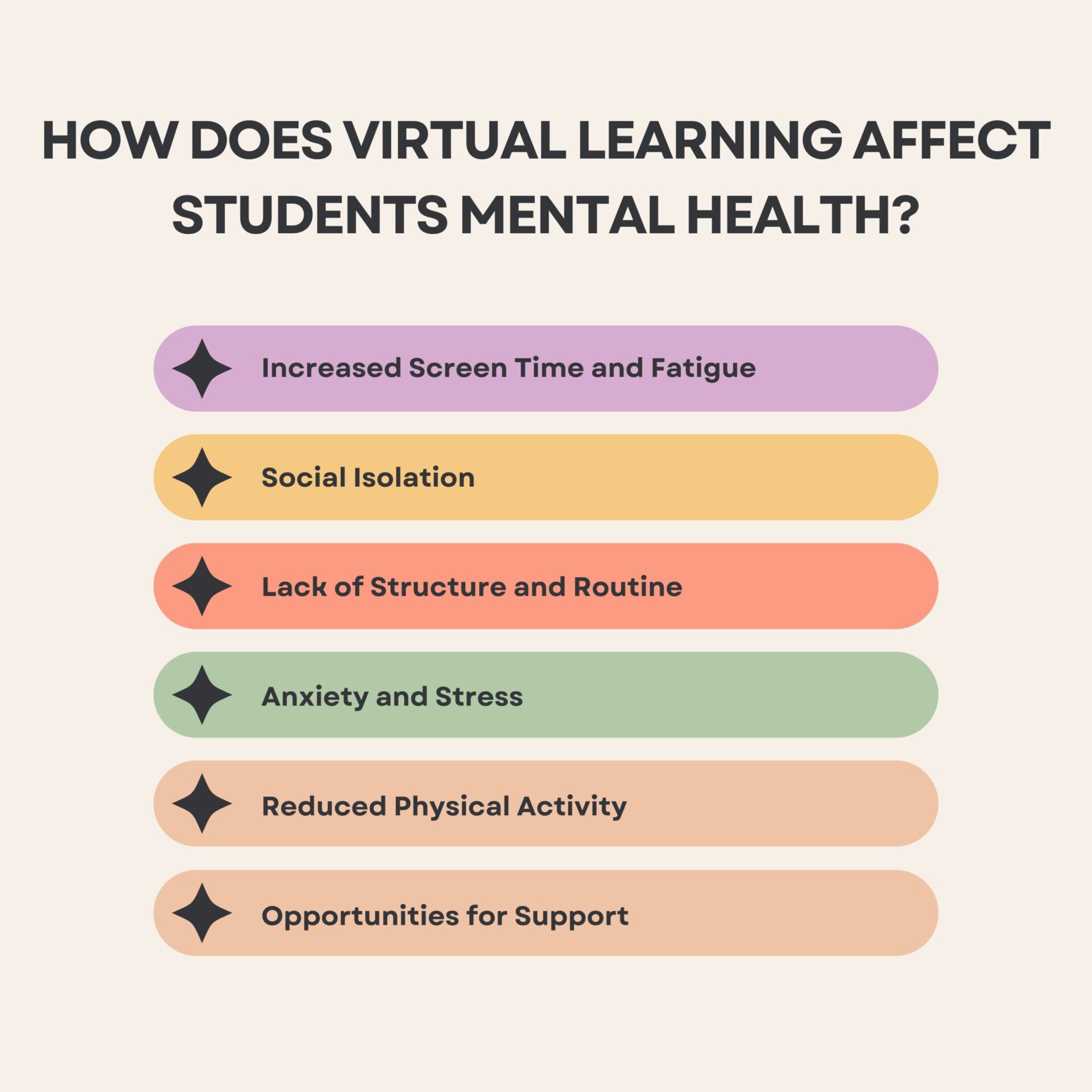Introduction
The rapid shift to virtual learning, while offering flexibility and accessibility, has also raised concerns about its impact on students’ mental well-being. This article examines the complex relationship between online education and mental health, exploring both the challenges and opportunities it presents, and offering practical strategies to support students in this evolving educational landscape.

Challenges of Virtual Learning for Mental Health
Social Isolation and Reduced Interaction: Traditional classrooms provide crucial social interaction and peer support. Virtual learning can lead to feelings of isolation and loneliness, impacting students’ emotional development and sense of belonging. The lack of casual interactions and group activities can be particularly challenging for younger students.
Increased Screen Time and Digital Fatigue: Prolonged screen time is inherent in virtual learning, contributing to digital fatigue, eye strain, headaches, and difficulty concentrating. This physical discomfort can exacerbate existing mental health issues and create new ones.
Self-Regulation and Structure: Virtual learning requires significant self-discipline and time management skills. The lack of a structured classroom environment can make it challenging for some students, especially younger ones, to stay organized, motivated, and on track with their studies. This can lead to increased stress and anxiety.
Anxiety and Performance Pressure: The technical challenges of online learning, coupled with the pressure to succeed academically, can contribute to anxiety and stress. Students may worry about technical difficulties, their performance in a less structured environment, and the perceived lack of direct support from teachers.
Blurred Boundaries Between School and Home: Learning from home can blur the lines between academic and personal life. This can make it difficult for students to switch off from school and can lead to feelings of being constantly “on,” contributing to stress and burnout.
Benefits of Virtual Learning for Mental Health

While virtual learning presents challenges, it also offers potential benefits for some students:
Increased Flexibility and Accessibility: The flexibility of online learning can be particularly beneficial for students with anxiety or other mental health conditions that make attending traditional school difficult. It allows them to learn at their own pace and in a comfortable environment.
Reduced Social Pressure: For students who experience social anxiety or bullying in traditional school settings, virtual learning can provide a safer and more comfortable learning environment. It reduces the pressure of constant face-to-face interaction.
Access to Wider Resources and Support: Online platforms can offer access to a wider range of resources and support services, including mental health apps, online counseling, and virtual support groups. These resources may be more accessible and convenient for some students.
Strategies for Supporting Students’ Mental Health in Virtual Learning
Promote Social Connection: Encourage students to participate in online clubs, virtual study groups, and other social activities to foster a sense of community and reduce feelings of isolation.
Establish Healthy Screen Time Habits: Educate students and parents about the importance of taking breaks from screens, engaging in physical activity, and maintaining a healthy sleep schedule.
Develop Self-Regulation Skills: Provide students with strategies and tools for time management, organization, and self-discipline. Help them create a structured learning environment at home.
Provide Mental Health Support: Ensure that students have access to mental health resources, such as online counseling, virtual support groups, and mental health education programs.
Foster Open Communication: Create a safe and supportive environment where students feel comfortable discussing their concerns and seeking help when needed. Regular check-ins with students can help identify those who may be struggling.
Engage Parents and Families: Partner with parents and families to support students’ mental health. Provide resources and information about the challenges of virtual learning and strategies for coping.
Create a Supportive Learning Environment: Foster a positive and inclusive online learning environment where students feel valued and supported. Encourage collaboration, communication, and mutual respect.
Offer Teacher Training: Provide teachers with training on how to recognize and address mental health concerns in a virtual learning environment.
Conclusion
Virtual learning presents both challenges and opportunities for students’ mental health. By understanding these complexities and implementing proactive strategies, educators, parents, and students can work together to create a positive and supportive online learning experience that promotes well-being and academic success. The key lies in fostering connection, promoting healthy habits, and ensuring access to the resources and support students need to thrive.
Author

Avidon Health is transforming how organizations promote healthier lifestyles through behavior change science and technology-driven coaching. Our mission is to empower individuals to achieve better health outcomes while driving measurable business success for our clients.With over 20 years of expertise in health coaching and cognitive behavioral training, we’ve built a platform that delivers personalized, 1-to-1 well-being experiences at scale.Today, organizations use Avidon to reimagine engagement, enhance health, and create lasting behavior change—making wellness more accessible, impactful, and results-driven.
